OnePager Import of Data from Project for the Web for Version 7.2
Contents
- 1 Introduction
- 2 About Connecting and Importing Project for the Web Data to OnePager
- 3 Selecting Tasks for Import into OnePager
- 4 OnePager Chart Representation of User Defined Columns and Virtual Columns
- 4.1 Project for the Web User Define Columns
- 4.2 OnePager Virtual Columns for Project for the Web, an Example
- 4.3 More OnePager Virtual Columns for Project for the Web
- 4.4 Representing Percent Complete (% Complete) from Project for the Web Project Formatted Files
- 4.5 Cannot Represent Single or Multiple Resources from Project for the Web
- 4.6 Representing Baseline Data from Project for the Web Import Source Plans
- 4.7 Representing Critical Path Segments from Project for the Web Project Formatted File
- 4.8 Using the OnePager Deadline Representation Feature with Project for the Web
- 4.9 Using the OnePager Endpoints Representation Feature with Project for the Web
- 4.10 Representing Task Links from Project for the Web Project Formatted Files
- 5 Related Links
Introduction
The purpose of this article is to provide you one place with as much information as possible about how OnePager is used to create OnePager charts with data imported from Microsoft's Project for the Web.
In most cases OnePager handles data fields from Project for the Web very much like data coming from Microsoft Project. This article focuses on two major topics:
- 1) Connecting to and importing Project for the Web data into OnePager.
- 2) OnePager’s handling of specific Project for the Web column data once those data are imported.
As a convention, whenever we refer to the OnePager in the context of Project for the Web, we'll just say OnePager when it’s absolutely clear that we are discussing OnePager with Project for the Web. Since only the Standalone edition of OnePager connects to Project for the Web files online, we'll just leave the suffix "Standalone" off.
About Connecting and Importing Project for the Web Data to OnePager
OnePager imports data from Project for the Web by first making the connection from OnePager to your Project for the Web account online. Therefore, you must first have a Project for the Web account and login credentials so OnePager can access your account, your Project for the Web files, and be able to download selected file or files to your computer.
Detailed information on setting up you Project for the Web data for import to OnePager and other topics related to getting started using OnePager Bundle can be found at this article:
| Using Microsoft Project for the Web Source Plans with OnePager |
Data Imports to OnePager
OnePager expects that you created a Project for the Web Project formatted file from one of the many available Project for the Web templates. In most cases, the column headings for the Project formatted file look like this:
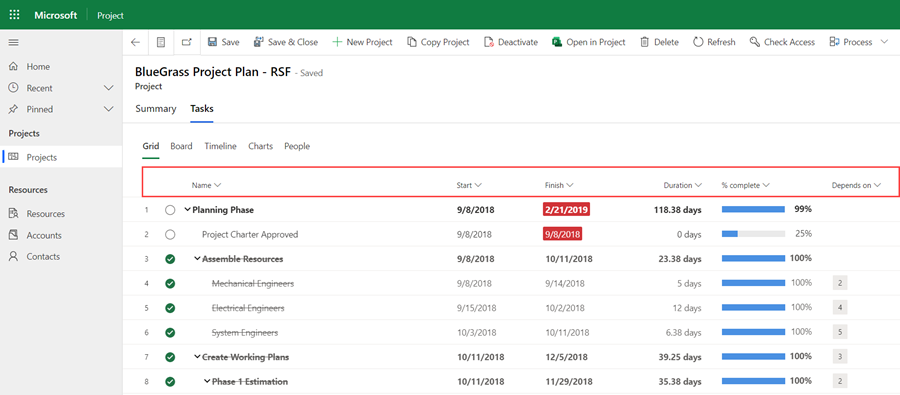
Minimum Column Names and Flags
The minimum Column names needed by OnePager are the Task Name, Start, and Finish. For those OnePager Pro users, Project for the Web does not make Boolean fields available to OnePager that are used by OnePager Pro to select tasks for import. To provide a means for you to have control over the tasks you require to be shown in OnePager from Project for the Web source plans, OnePager provides a new form accessed from the OnePager choices form or OPC form that can be used for this purpose. More information on how to select tasks using the Project for the Web Task List form is provided below.
Adding Your Own Columns
Project for the Web features the capability for you to add your own User Defined Columns to the Project formatted file which OnePager imports. These additional column names can be used to organize your OnePager chart such as for defining Rows and Swimlanes in the chart or for presenting text information to be displayed in the chart as text columns. As a further example, the illustration below shows several User Defined Columns that can provide data for the OnePager chart and enhance your schedule presentation:
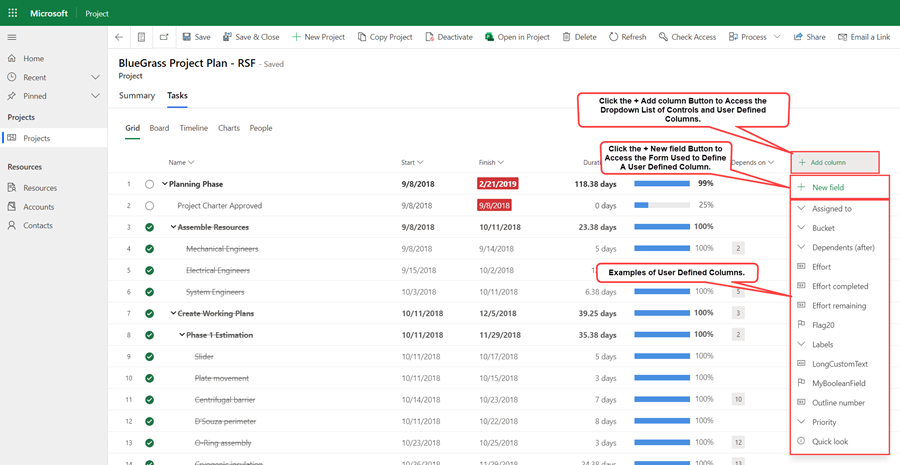
OnePager Recognized Data Types
What follows is a short discussion of how OnePager applies it’s built in intelligence functions with respect to Project for the Web’s User Defined Columns. The goal here is to provide an understanding of the process so you know what to expect from OnePager when various column heading names and data (column) types are encountered by OnePager in your Project for the Web source plan. There are four (4) column types that OnePager looks for when importing data from Project for the Web:
- Dates
- Numbers
- Text Strings (A through Z, 0-9, special characters)
All data, regardless of data type, are imported from Project for the Web Project formatted files. OnePager begins this analysis from top-left to bottom-right. Once the column headers are located and the data types are analyzed, OnePager associates these columns with specific usages in the OnePager choices (OPC) form as illustrated below. Using the second page of the OPC form shown below, you can change the column usage by selecting another column to serve the function from the dropdown list provided. The dropdown list is built from all the column headers that OnePager found during its analysis pass. An example of a dropdown list of column header names taken from a Project for the Web source plan is shown here:
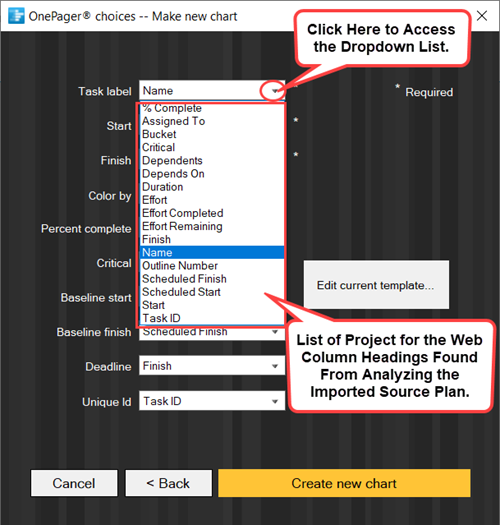
Highlighted above is the second page of the OnePager choices form showing a dropdown list of Project for the Web available column names along with virtual column names created by OnePager.
Selecting Tasks for Import into OnePager
Since OnePager is connected to your Project for the Web account, it has access to your Project formatted files. Anyone of these files can be imported into OnePager and a chart created. The benefit derived from OnePager is that you can select the tasks you which to display in your OnePager chart along with other decorations and features that are best for presentation in a schedule discussion.
When making your first chart, we strongly recommend that you import 50 or fewer Tasks. Please note that OnePager is shipped with a number of fully populated templates that are based on the Project for the Web source plan used in the Tutorial shipped with the product – BlueGrass Project Plan. Three column headings must always be present as a minimum: Task Name, Start Date, and Finish Date.
Once you’ve made the determination which source plan tasks to import you can launch OnePager and create your OnePager chart.
This discussion continues at this link:
| Launching OnePager Using Microsoft Project for the Web Source Plans for the First Time |
There are three (3) selection options available for controlling OnePager’s import of task data. These are discussed in the subsections that follow:
Task Selection Option (1): Select All Tasks
Project for the Web source plans like the one shown above with many tasks results in a very large OnePager chart usually not suitable for detailed schedule conversations. Accordingly, we do not recommend importing more than 50 tasks so that the resulting chart is a useful one page rendering of the source plan. However, for small projects where the number of tasks falls below the recommended maximum, using the Select all tasks shown in the Task Selection sub-control group of the OnePager choice form below is an easy way to specify this option:
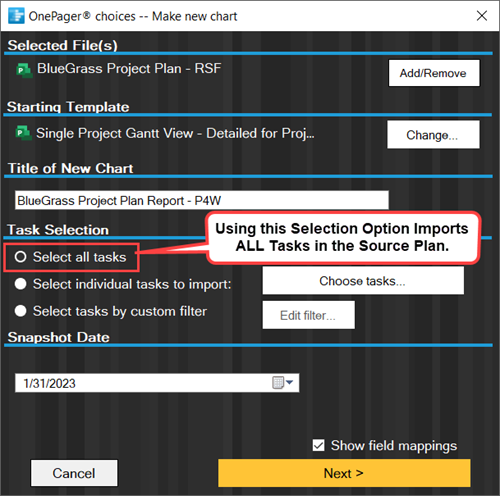
Task Selection Option (2): Select individual task to import:
This task selection option is recommended because it provides you with control over all the tasks in the source plan that can be imported. Clicking the Select individual task to import: radio button or the Choose tasks button accesses the Project for the Web Task List form as shown below:
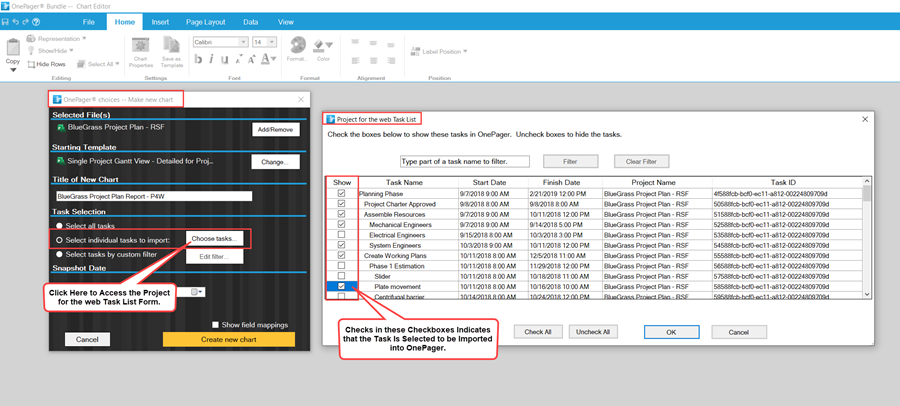
The Project for the web Task List form is displayed with the Show column having all its checkboxes checked OFF or blank. Check the checkbox ON for each task listed in the grid that you intend to import into OnePager for your chart. The Project for the web Task List form's allow you to:
- Check All tasks
- Uncheck All tasks
- Filter specific tasks to be shown
- Sort the Sequence, Task Name, Start Date, Finish Date, and Task ID columns into ascending or descending order.
Shown in the illustration above is the file name for the Microsoft Project for the Web source plan and the distributed Microsoft Project for the Web Template Properties form that OnePager selects as a starting point for you. Also shown above is the name selected for the OnePager Bundle NEW chart. At this point you can change the Template Properties form used to build the chart by clicking the Change button in the Starting Template sub-section of the OnePager Choices form.
Task Selection Option (2) for Chart UPDATE and OPEN
When a Project for the Web chart was created earlier, you have the capability to UPDATE or OPEN the chart at a later time. Task Selection Option (2) is available in UPDATE and OPEN modes of OnePager operation. OnePager keeps the contents of the Project for the web Task List with the created chart so that the chart looks the same as when it was first created. After clicking the UPDATE or OPEN button in the OnePager Bundle Start form, OnePager Bundle accesses the OnePager choices -- Update form where you can click the radio button for the Select individual tasks to import: and the Choose tasks... button to access the Project for the web Task List form. Upon doing this, OnePager Bundle accesses the Project for the web Task List form where you have the option to change your selections.
Task Selection Option (3): Select Tasks by custom filter: (Conditional Import Rules)
You can use the Conditional Import feature to fine tune the tasks you want to import. Assuming that you’re familiar with the Conditional Import feature, the Conditional Import Rules form can be accessed by selecting the Select tasks by custom filter: radio button as shown in the illustration below. Using the Conditional Import Rules form as shown here, it is possible to select tasks between specified Start Dates and Finish Dates:
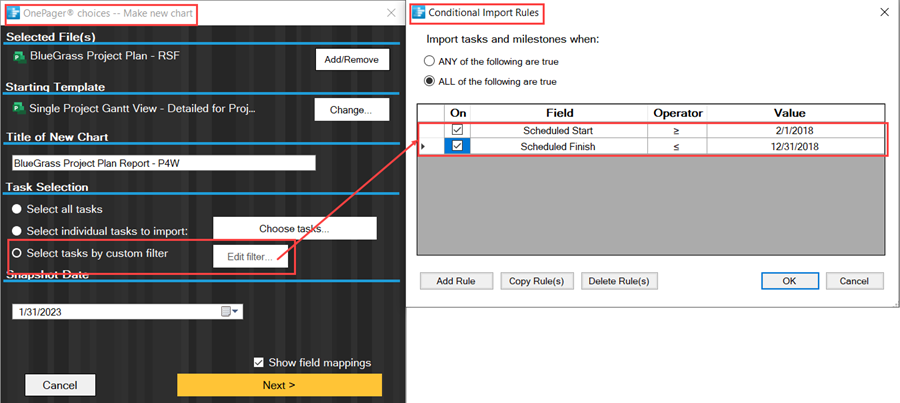
When the above Conditional Import rules are used in the selection process, the resulting chart looks like this:
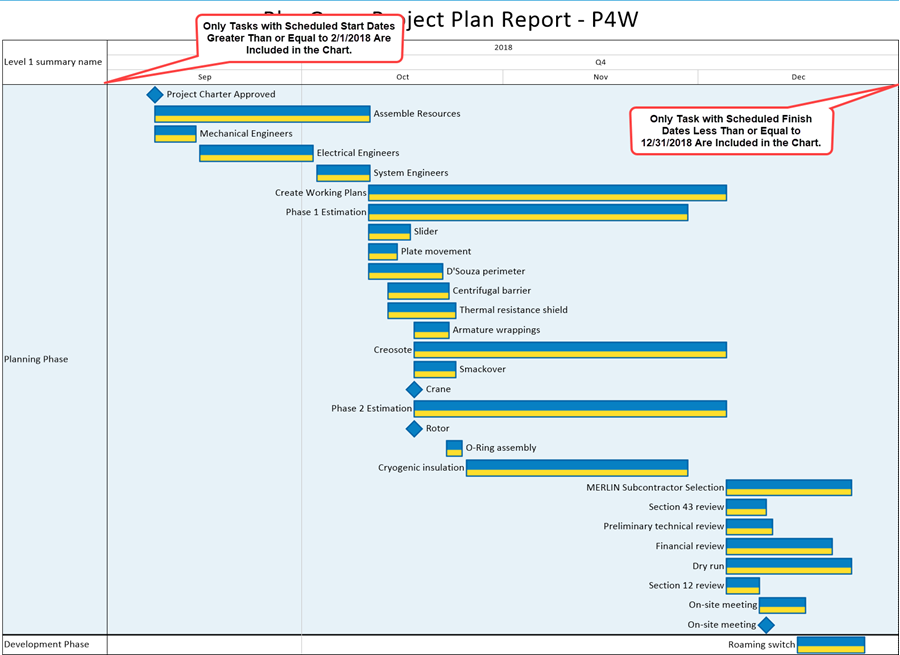
The illustration created above includes tasks within the Scheduled Start Dates and Scheduled Finish Dates included in the Conditional Import Rules form. The Conditional Import Rules form with the three rules is shown below:
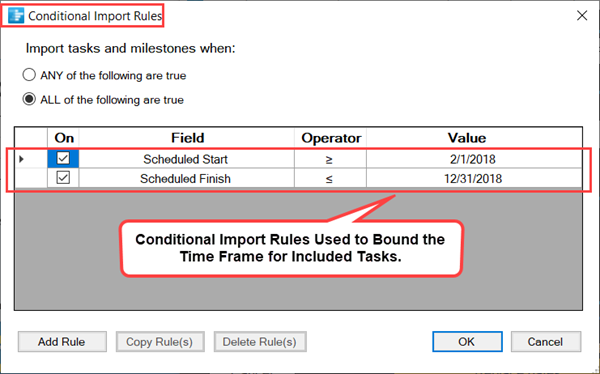
Any Project for the Web column found in your source plan can be used as a Field in a Conditional Import rule.
For more detailed information on the Conditional Import feature, we recommend that you read the articles on this subject under:
| Conditional Import Filters (Portal) |
OnePager Chart Representation of User Defined Columns and Virtual Columns
OnePager imports all Project for the Web columns at the beginning of the chart building process and analyzes them for data type and how they may be used in charts. Project for the Web has a minimum number of defined columns. Project for the Web users can add User Defined Columns to their source plans as needed to suit their scheduling goals. As explained below, Project for the Web User Defined Fields are not available to OnePager.
Project for the Web User Define Columns
The OnePager intelligent preprocessor imports all available columns and analyzes them to set up dropdown lists of imported columns that are available within OnePager’s control scheme. However, it must be kept in mind that Project for the Web does not make it's source plan's User Defined Columns available to OnePager at this time. As a result, OnePager cannot see Project for the Web User Defined Columns from your source plans and, therefore, these columns do not appear in column dropdown lists available to you in OnePager.
Should your requirements for schedule conversations using Project for the Web require the use of User Defined Fields, we encourage you to contact Microsoft Corporation to express your needs at this link:
| Make Project custom fields discoverable via Microsoft.Xrm.Sdk |
OnePager Virtual Columns for Project for the Web, an Example
OnePager also builds additional “virtual” columns for use in your charts that are constructed based upon data imported from your Project for the Web Project formatted file. These virtual columns are provided in OnePager so that you can use all the features of OnePager when designing your charts.
OnePager Pro and OnePager Express users have found it beneficial to use many of the OnePager virtual columns in their charts as shortcuts. For example, take the Project for the Web source plan below that has indented task names that establishes a Work Breakdown Structure:
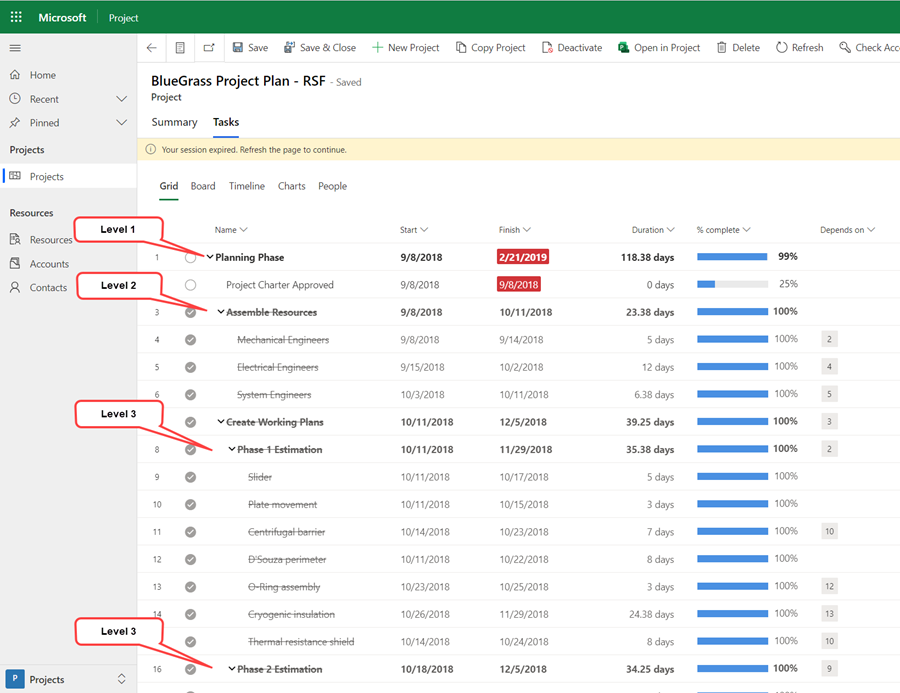
Creating the OnePager chart from the Project for the Web source plan above, we get this:
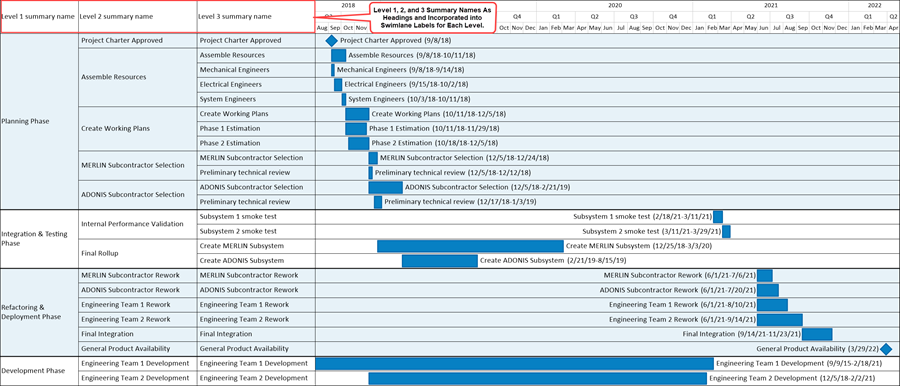
This is just one example of the use of OnePager virtual columns.
The OnePager virtual columns used in the example above represent only three of the virtual columns available for use in charts. OnePager can represent up to ten (10) levels for Summary name and Summary ID. The list of Level “x” Summary name and Level “x” Summary ID is shown in this illustration of a Swimlane Group by dropdown list:
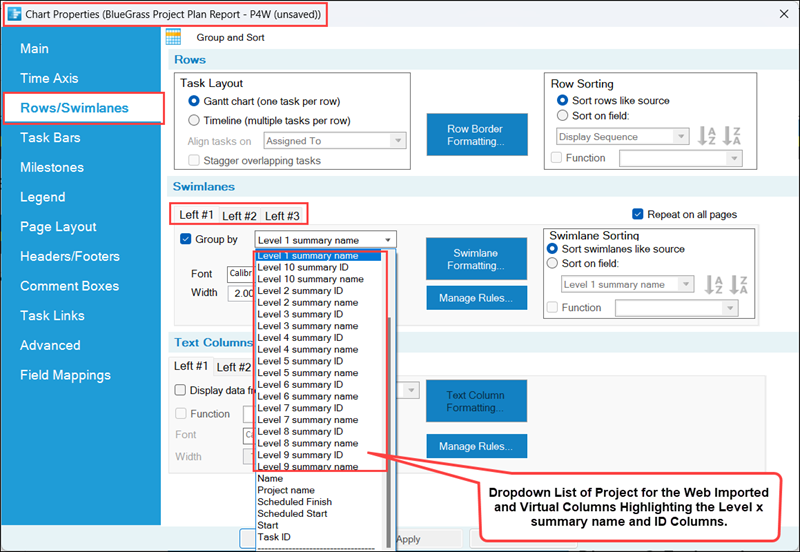
For more information on the use of Rows and Swimlanes, please see the articles at:
| Creating and Editing Rows and Swimlanes (Portal) |
| Rows/Swimlane Tab |
More OnePager Virtual Columns for Project for the Web
As mentioned above, OnePager adds virtual columns, and in most cases populates these virtual column cells with data imported from your Project for the Web source plan as illustrated above.
The following virtual columns available in OnePager charts built with Project for the Web source plans are discussed in the sub-sections below:
- Task ID
- Outline number
- Level “x” summary ID/name
- Critical
Task ID Columns
The Task ID, created from the Project for the Web source plan’s data and maintained by OnePager, is the Project for the Web task’s internal Project for the Web identification number. Task ID is the number associated with the task name shown in the Project for the web Task List form accessed from the OnePager choices form. Displaying Task ID in one of the OnePager chart text columns is a convenient way to relate task bars back to source plan task numbers.
To illustrate Task ID consider the source plan as shown below:
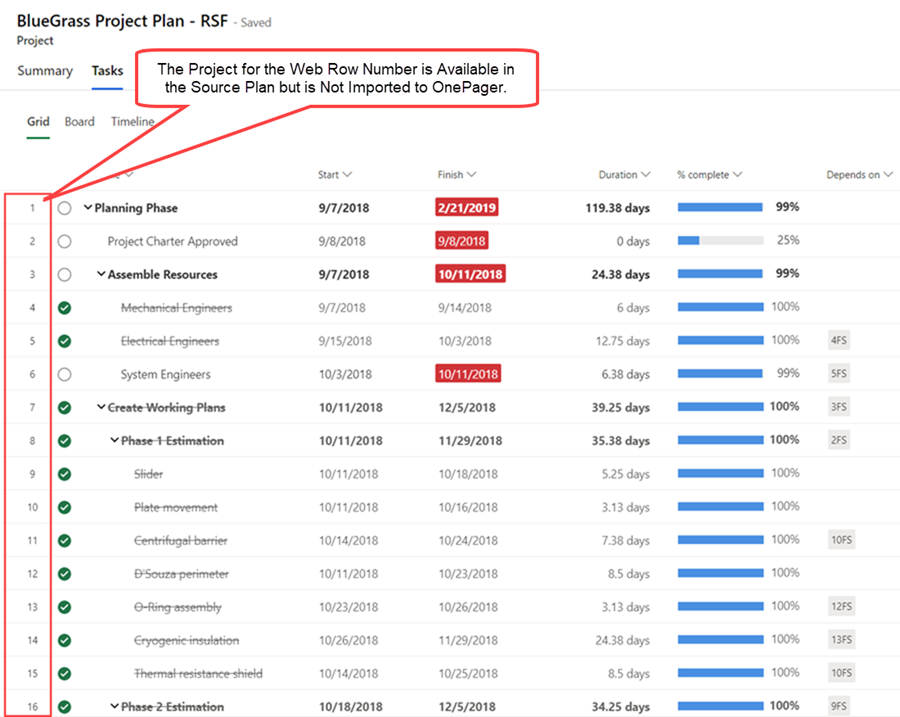
If the Project for the web Task List form is configured with the first fifteen (15) checkboxes checked ON, OnePager imports these tasks along with the associated Task ID value shown in the Project for the web Task List form shown here:
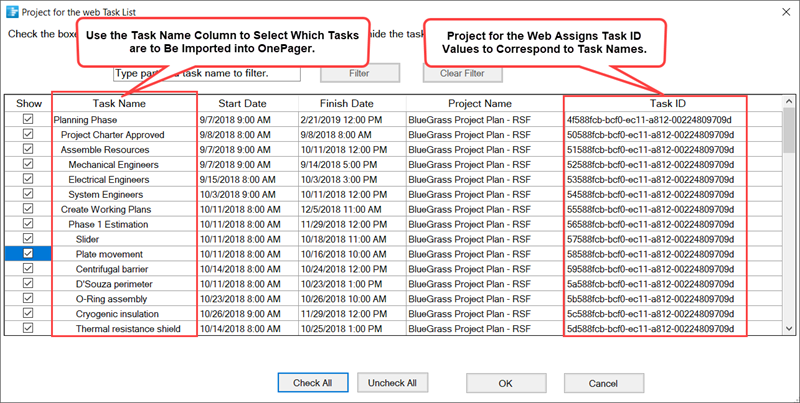
When this source plan segment above is imported to OnePager and a chart is created, the portion of the chart containing the above fifteen (15) tasks looks like this with the corresponding values for Task ID:
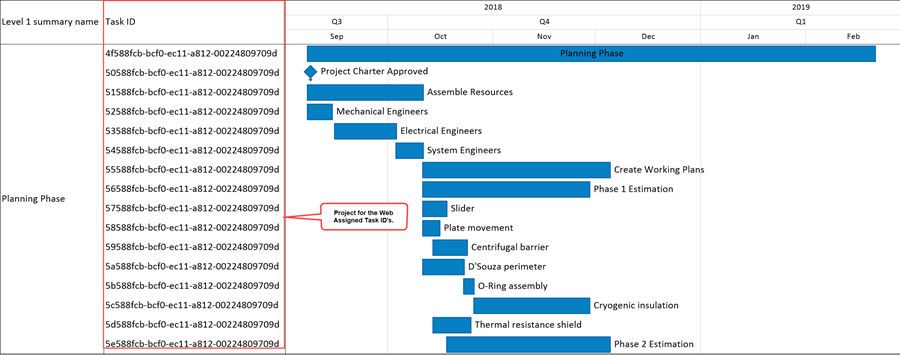
Outline Level Column
The Outline Level column provides an integer value counting the level of indentation of task bars starting at level one (level 1).
The Outline Level is shown in the source plan below:
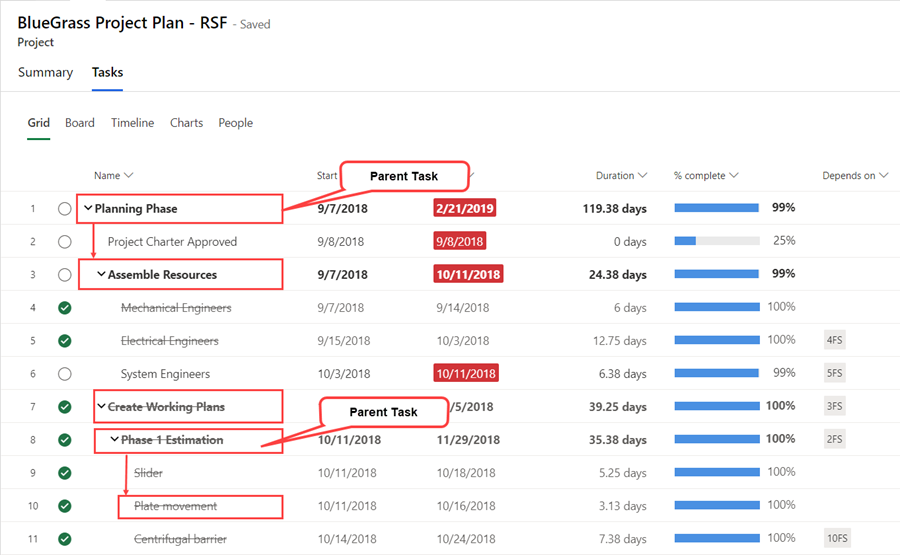
In the Project for the Web source plan above, Planning Phase is at the highest level with Project Charter Approval, Assemble Resources and Create Working Plans at the next level down. Additionally, Mechanical Engineers, Electrical Engineers, and System Engineers are at one more subordinate level below Assemble Resources. Finally, Phase 1 Estimation is at a subordinate level below Create Working Plans. There are four levels represented in the source plan shown above and when it is imported to OnePager, the chart portion looks like this with the Outline Level column containing the level values in each cell:
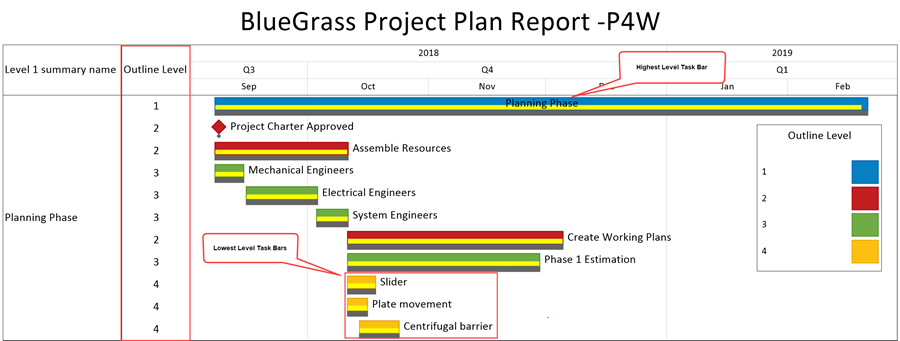
The Outline Level values shown above represent the WBS levels for the displayed portion of the source plan.
Level “x” summary ID/name Fields
OnePager provides a feature that allows you to conveniently display levels of indention based upon the source plan’s Work Breakdown Structure. OnePager supports ten (10) levels of indention which can be based on the ID or the Name of the WBS Element.
As an example, take the portion of the Project for the Web BlueGrass Project Plan shown below and note how OnePager interprets the WBS:

When the OnePager chart is created using the Project for the web Task List form to control the import of data and the Left#1 swimlane is set to Level 1 summary name, the Left#2 swimlane is set to Level 2 summary name, and the Left#3 swimlane is set to Level 3 summary name, the chart looks like this for the portion of the source plan above:

Critical Column
Project for the Web doesn't shows the critical path in the Gantt bar display as shown below:
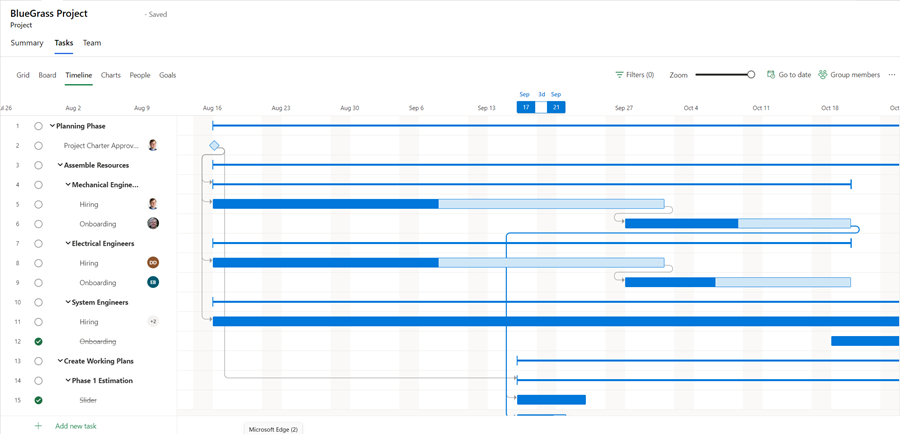
The Critical column is a Boolean value column whose cells either contain the word “True” or “False” depending on whether the individual task is ON or Not ON the critical path. These values are shown in the chart below in the Critical column:
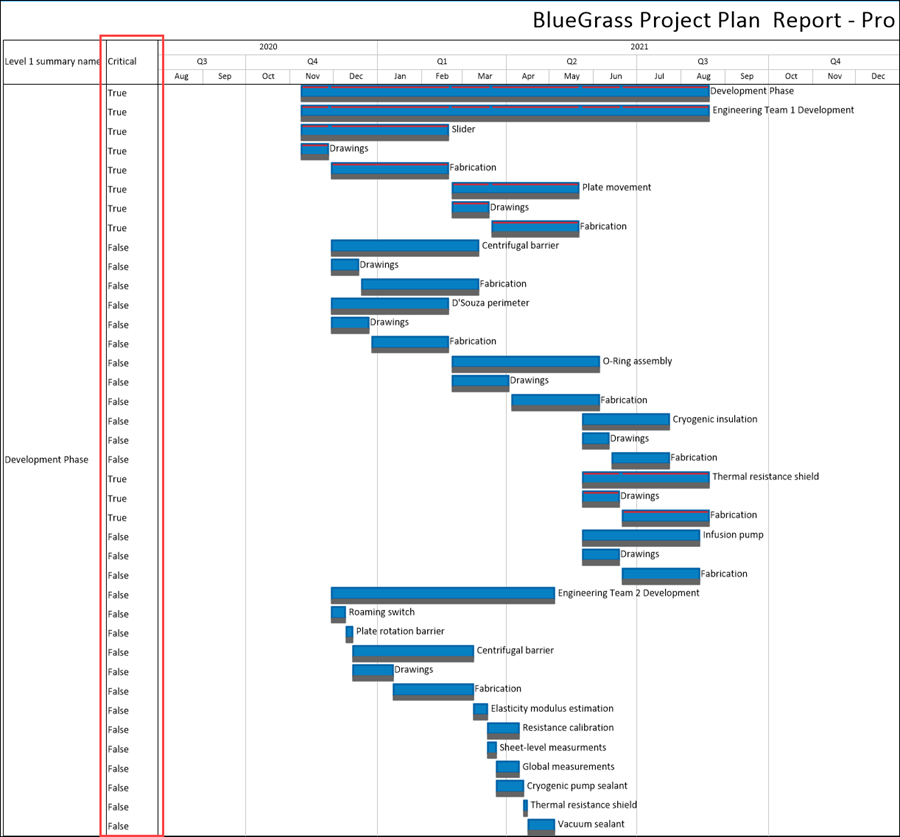
In the illustration above, all task bars that have “True” in their Critical column cells are on the critical path as calculated by Project for the Web.
Representing Percent Complete (% Complete) from Project for the Web Project Formatted Files
Project for the Web has an available column called % Complete which can be populated with data that indicates the extent to which a task is progressing. The % Complete column’s cells are automatically populated with your numeric value followed by a percent sign (%). A sample portion of a Project for the Web source plan looks like this with the % Complete column highlighted:
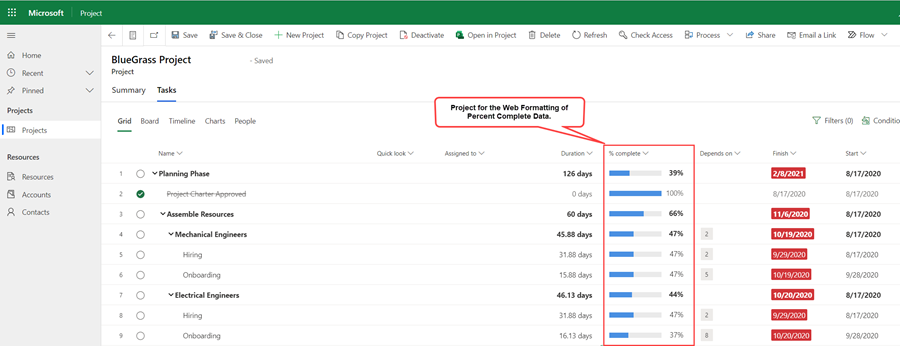
The OnePager chart created from the above Project for the Web source plan looks like this:

Since Project for the Web has a defined column called % Complete, it is our recommendation that you use this Project for the Web defined column in your charts to represent percent complete for tasks and milestones.
For more information on using the percent complete feature, please see the article at:
| Percent complete for OnePager |
Cannot Represent Single or Multiple Resources from Project for the Web
Project for the Web source plans are capable of identifying resources and associating them with tasks. However, Project for the Web resources are not provided to OnePager Bundle. The consequence of this is that resources types are not represented in OnePager imported fields dropdown lists and therefore multiple resources cannot be shown in the chart and cannot be split.
Representing Baseline Data from Project for the Web Import Source Plans
When the Project for the Web source plan is configured with baseline start/finish dates, OnePager can represent them in the chart when the Chart Properties form’s Task Bars and/or Milestones tabs are configured to do so as shown below:
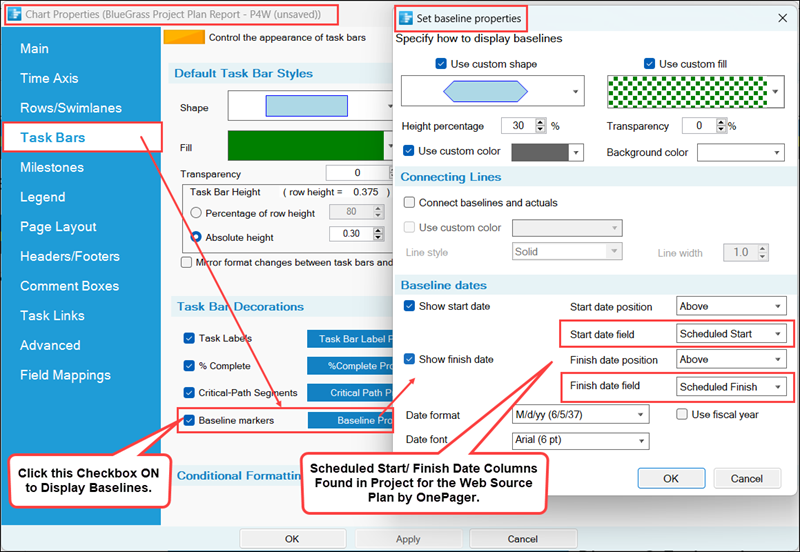
When the Baselines function is enabled and the Baseline start/finish dates are displaced to the right of the baseline shape, the chart looks like this:

For more information on Baseline representation, please see the article:
| Baselines for OnePager |
Representing Critical Path Segments from Project for the Web Project Formatted File
When the Project for the Web source plan is configured to produce critical-path segments, OnePager can represent them in the chart when the Chart Properties form’s Task Bars and/or Milestones tabs are configured to do so as shown below:
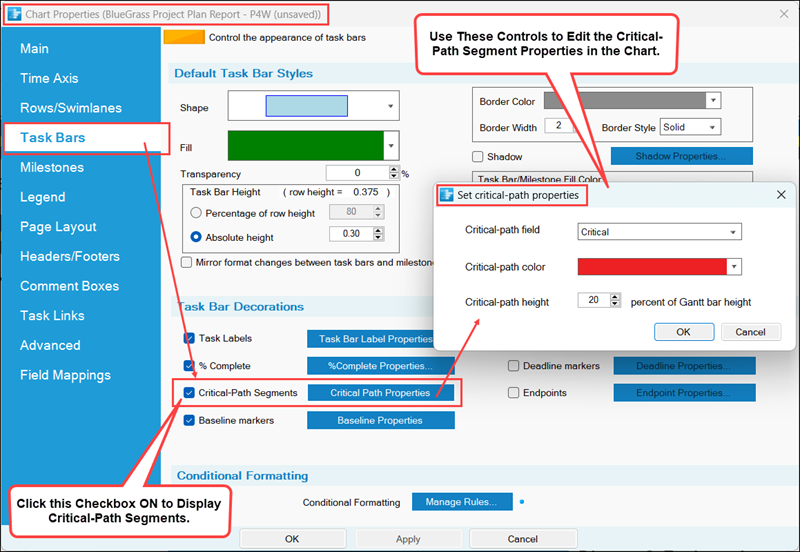
OnePager can represent critical-path segments in the chart as calculated by Project for the Web and as shown in the source plan. OnePager imports the data from a Boolean column named Critical as shown below:

For more information on Critical-Path Segments, please see the article:
| Critical path for OnePager |
Using the OnePager Deadline Representation Feature with Project for the Web
Microsoft's Project for the Web does not have a specific Deadline column available in the source plan. Additionally, User Defined Columns are not available to OnePager at the present time. As a consequence, all Project for the Web distributed Template Properties forms are set to use the Project for the Web Finish column as the default Deadline field. You have the option using the second page of the OnePager choices form shown below to select another date field:
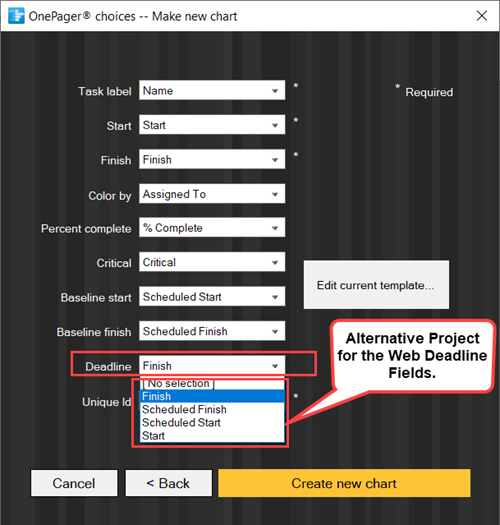
OnePager's Deadline feature lets you display a deadline symbol in the chart that represents the latest finish date for the task or when the milestone must be met. A portion of a chart with deadline symbols looks like this:

When deadlines are turned ON, they appear (by default) as down-arrow symbols in each task bar's row at the deadline date position with respect to the time axis. Above, deadline symbols that are not contained within their respective task bar are shown with black dash-dot connecting lines to illustrate the capability.
It is highly recommended that if you want to use the deadlines feature that you use an available Project for the Web column as your Deadline column in your source plan and populate it with appropriate dates. When OnePager imports your source plan this “Deadline” containing the dates for this purpose and populates the appropriate dropdown lists.
Controls for displaying deadline symbols are provided in the Template Properties and Chart Properties form’s Task Bars and Milestones tabs where you can specify the Project for the Web source plan column to represent deadline dates and specify their graphical representation in the chart.
For convenience, OnePager assumes that the Project for the Web Project formatted file’s Deadline date column is the default column that OnePager uses to represent deadline symbols in the chart. This setting is established in all Project for the Web distributed Template Properties forms.
The deadline setting is established in all Project for the Web distributed Template Properties form’s Field Mappings tab as shown below:
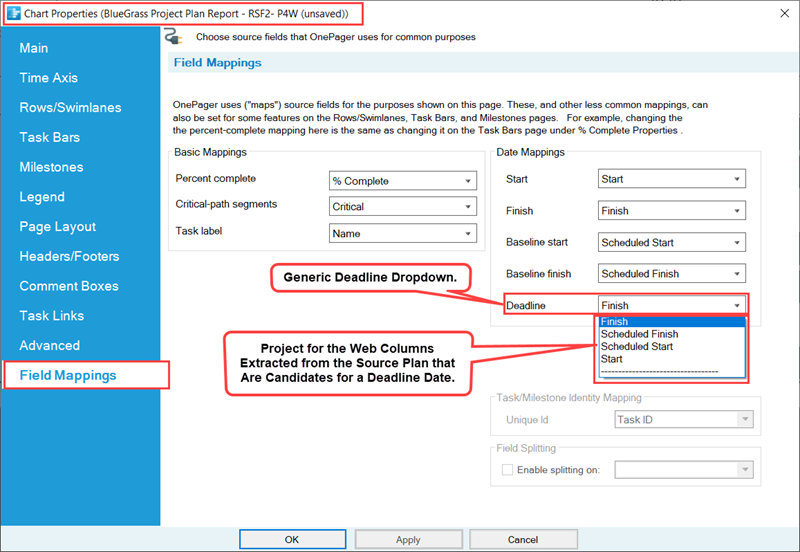
As shown above, the Deadline date column name can be changed before the chart is created by using the Template Properties form’s Field Mappings tab to select another preferred Project formatted date column. Changing the Deadline date column name after the chart is created requires using the Field Mappings tab in the Chart Properties form.
For more information on using Deadline symbols, please see the article at:
| Deadlines for OnePager |
Using the OnePager Endpoints Representation Feature with Project for the Web
Microsoft's Project for the Web does not have Endpoint columns available in the source plan. Additionally, User Defined Columns are not available to OnePager at the present time. Finally, the OnePager choices form's page 2 does not offer an option to select an available Project for the Web column to serve as a source column for one or all of the four Endpoints supported by OnePager. You do have the option, alternatively, to use the Set endpoint properties form accessible from either the Template Properties form or the Chart Properties form to select Project for the Web columns to serve as endpoints as shown below:
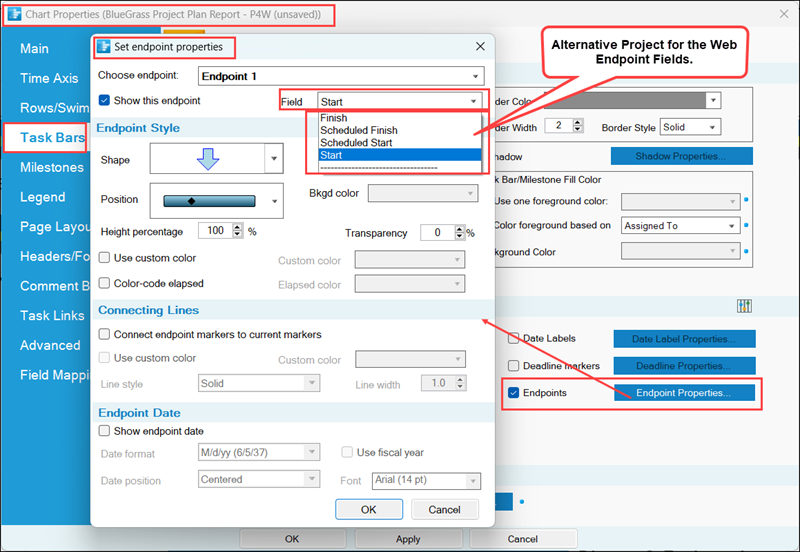
OnePager's Endpoints feature that lets you display a multiple endpoint symbols in the chart that represent potentially important dates for a task. A portion of a chart with four (4) endpoint symbols associated with each task bar looks like this:
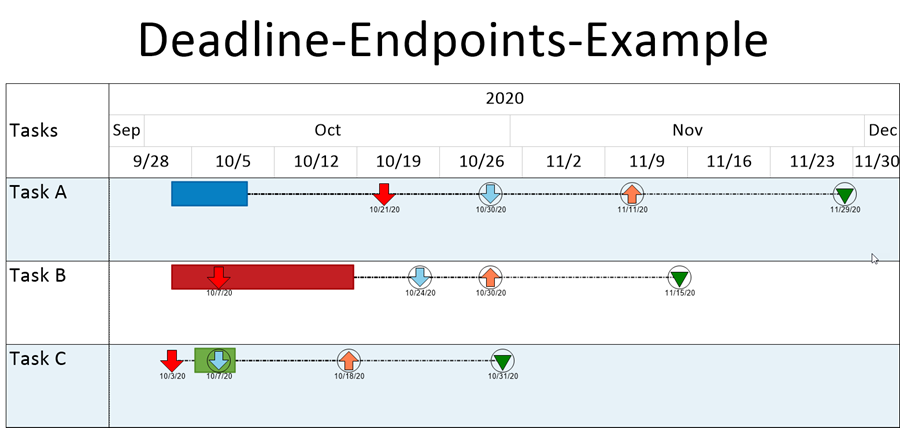
When one or more endpoints are turned ON, they appear (by default) as down-arrow symbols in each task bar's row at the endpoint’s date position. Above, endpoint symbols that are not contained within their respective task bar are shown with black dash-dot connecting lines to illustrate the capability.
Controls for displaying endpoint symbols are provided in the Template Properties and Chart Properties form’s Task Bars and Milestones tabs where you can specify the Project for the Web source plan column to represent endpoint dates and specify their graphical representation in the chart.
For convenience, OnePager assumes that the following Project for the Web Project formatted date columns are the default columns that OnePager uses to represent endpoint symbols in the chart:
- Endpoint 1: Start
- Endpoint 2: Finish
- Endpoint 3: Start
- Endpoint 4: Finish
These setting are established in all Project for the Web distributed Template Properties form’s Task Bars tab in the Task Bar Decorations sub-control group at the Endpoints button. (Milestones do not display Endpoint symbols.) Checking the Endpoints checkbox ON and clicking the Endpoints Properties… button accesses the Set endpoint properties form where the default endpoint dates can be changed before the chart is created. Following the same path in the Chart Properties form to the Set endpoint properties form can accomplish the same result after the chart is created.
For more information on using Endpoint symbols, please see the article at:
| Endpoints for OnePager |
Representing Task Links from Project for the Web Project Formatted Files
OnePager displays Task Links in the chart when the “master switch” for Task Links in the Template Properties form’s Task Link tab is checked ON as shown below:
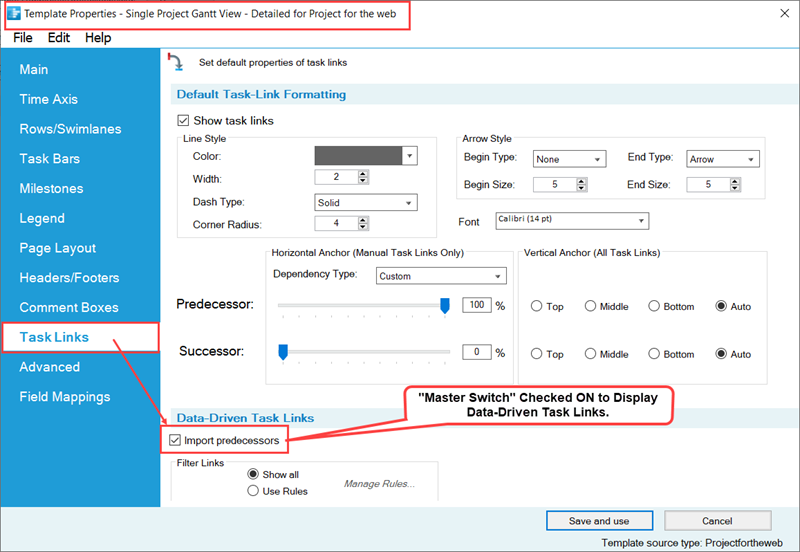
When the “master switch” is checked ON, Task Links are enabled and can be shown in the chart after the Show data-driven links checkbox is checked ON in the Chart Properties form’s Task Link tab as shown below:
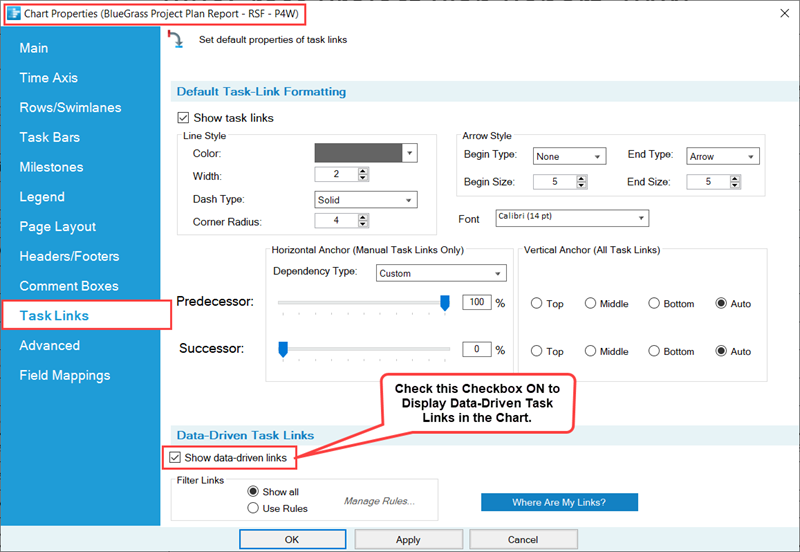
You can use the above form to change the properties of the Task Links to meet your schedule discussion needs.
As an example, if we look at the Depends on column in the source plan below we see that there are values corresponding to row numbers and the type of constraint appear to be finish to start (FS):
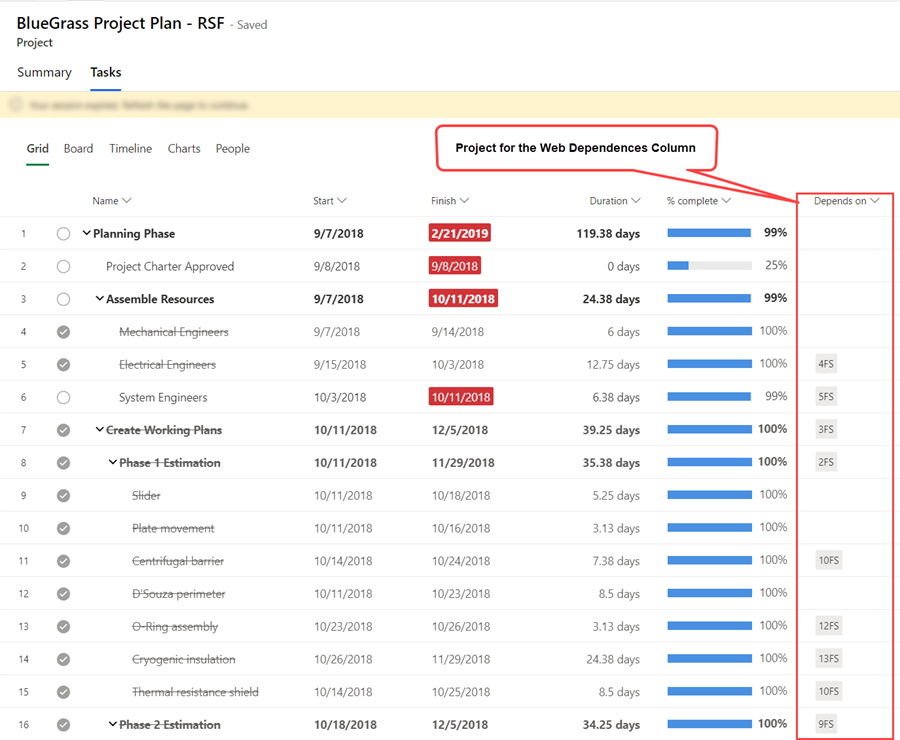
For clarity, Project for the Web provides two (2) column fields that OnePager accesses to completely define Task Link relationships in the chart. These columns are: (1) the Depends on column shown in the above illustration and (2) the Dependents column. If we add these two OnePager columns to the chart as text columns Left#1 and Left#2, the chart with Task Links displayed in red looks like this:
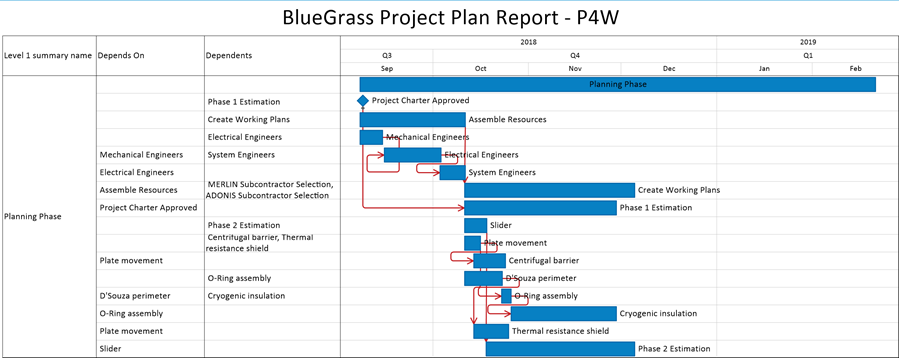
For more information on Task Links, please see the articles at:
| Linking Task and Milestone Using Manual and Data-Driven Task Links (Portal) |
Related Links
(4.0.1.9-72)